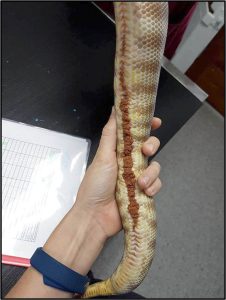EXO-Lesson 3- Burns

There are three different types of burns that can occur. One is called a thermal burn, one is a chemical burn, and the other is called an electrical burn.
Thermal burns can occur when bodily tissues remain in contact with a heat source for too long. This causes trauma and death to the tissues and can become a life-threatening issue if not treated promptly. An example of this would be placing your pet on a heating pad that is too hot and not providing them a place to move to when they become too hot. To treat these, you want to remove your pet from the heat source right away and rinse the area with lukewarm water. Never apply cold water to the injury, as this can cause vasoconstriction, leading to more tissue death.
Thermal burn from a malfunctioning heat mat
Chemical burns can occur when a corrosive chemical meets bodily tissues. This again causes trauma and death to the tissues if not treated promptly. To treat this type of burn, you want to remove your pet from the chemical or toxin, then wash the affected area with a luke-warm water and a gentle soap if necessary to remove any excess chemicals.
Electrical burns are caused by electricity passing through the body at a very rapid rate. These differ from chemical and thermal burns, as they can cause more damage to the underlying tissues. With these types of burns, there may be very little visible injuries on the surface of the skin. With these types of injuries, you will want to unplug the electrical cord and then remove your pet from the area. Seek treatment right away. These often occur when a heater in the habitat has a exposed power cord or if a pet bites a plugged in cord.
All three types of burns can range in severity of damage to the skin and underlying tissues. The skin is made up of three separate layers. The first is the epidermis, or the outer-most layer of the skin. The second layer is called the dermis. It contains hair follicles, sweat glands, and blood vessels. The third layer is called the subcutaneous layer. It is made up of mostly fat and connective tissues.
Burn Severity
- First degree burns affect the outer-most layer of the skin. There may be redness and itching present.
- Second degree burns occurs when the first layer and some of the second layer of skin are burned. These types of burns are also called partial thickness burns.
- Third degree burns occur when all three layers of the skin are burned. The skin may be discolored or have a leathery appearance. This type of burn can cause damage to nerves, bones, and muscle.
Complications with burns can arise when there is dehydration or secondary infection that may set in. Any type of burn should be evaluated by your veterinarian prior to applying any type of ointment or administering any medications.
